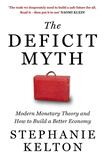
Milton Friedman once noted that when a crisis occurs, “the actions that are taken depend on the ideas that are lying around”. Indeed, it was many of his own ideas that became bedrocks of neoliberalism and using monetary policy to manage the business cycle following the stagflation of the 1970s.
As the initial shock and awe of Covid-19 ebbs to reveal economic wreckage that could ultimately dwarf that of the global financial crisis of a decade ago, finance ministers and fiscal pundits are flagging a future retreat to the orthodoxy of fiscal hawkishness. Austerity by any other name would smell so foul.
But what if one idea lying around were that the budget deficit didn’t matter – that fixation on debt sustainability was unhelpful myth-making? What if you could pay for the Covid-19 crisis, permanently improve the health system and end the housing crisis just by printing money?
With some caveats, this is the central premise of The Deficit Myth, a thought-provoking new work by Stephanie Kelton, leading evangelist of the modern monetary theory school of thought. Kelton is a razor-sharp writer, making accessible to noneconomists what can be technically challenging material in other hands. Smashing shibboleths of conventional economic wisdom, the author is unafraid to point out that the emperor has no clothes.
She argues passionately for a more progressive economy, starting by flipping the script on how we conceive public finances and monetary policy. While written as polemic, The Deficit Myth is theoretically sound, though occasionally politically naive.
In advanced economies, cautionary tales from the Weimar Republic, Zimbabwe and, more recently, Venezuela have made monetary financing taboo but not technically impossible
In 1971 Richard Nixon ended convertibility of the US dollar to gold, sounding the death knell for the Bretton Woods system and ushering in the age of free-floating fiat currencies. Kelton correctly observes that, since this “Nixon shock”, a government that both prints and borrows in its own currency – that has monetary sovereignty – can never go bust. In extremis, it can simply print more money, or mark up the government account at the central bank with a stroke of a keyboard. So the constraint becomes not the budget deficit per se but the impact the fiscal stance may have on inflation.
In advanced economies, cautionary tales from the Weimar Republic, Zimbabwe and, more recently, Venezuela have made monetary financing taboo but not technically impossible. Indeed, Japan is likely beyond the point of no return, as nobody really thinks its shrinking population can sustain a government debt ratio passing 250 per cent of gross domestic product.
Far from ignoring the inflation impact, as some of Kelton’s critics suggest, the author is at pains to stress this caveat. However, while repeating that there is “no free lunch”, she nonetheless fails to make explicit the “price” of her sumptuous menu of progressive economic policies. The reality is that if you double the minimum wage, pursue zero involuntary unemployment, and hugely increase public spending – all of which are, on their own, likely to be inflationary – then raising taxes to reduce the budget deficit (or even run a potentially large surplus) will be necessary if you are serious about controlling inflation. This is what “no free lunch” means.
Ultimately, whether you need to keep an eye on the budget deficit to ensure debt sustainability or to maintain price stability may not really matter. Moreover, the political economy of levying taxes to finance public goods would seem less complicated than doing so to control inflation.
It may be an inconvenient truth for some, but Ireland gave up central-bank independence to join the euro. The Central Bank of Ireland can no more unilaterally print euro than Kansas can print US dollars
Tax and spend policy is rightly the preserve of our elected representatives. Although introducing a permanent, well-designed job-guarantee scheme as an automatic stabiliser, as the author suggests, may help, controlling inflation would nonetheless rest on the heroic assumption that politicians would not just cut a cheque when the economy is weak but take away the punch bowl when the party gets going, ignoring the political cycle.
Putting monetary policy at a remove from democratic pressures is precisely why we have created another myth: that of central-bank independence. It can be ended if you can whip the votes. Ultimately, however, monetary policy is, and should be, responsive to both the general will and the public good.
Another important caveat to Kelton’s thesis is that it is only relevant to countries with monetary sovereignty. It may be an inconvenient truth for some commentators, but Ireland gave this up to join the euro. The Central Bank of Ireland can no more unilaterally print euro than Kansas can print US dollars. Even then, it would be naive to think that a monetary sovereign country the size of the UK would have the same degree of freedom in this regard as the US or Japan.
Modern monetary theory is an interesting alternative lens to better understand the constraints facing central banks and treasuries of some of the world’s leading economic players, but it should not be understood as a pain-free end to the budget constraint on economic policy. Death and taxes remain inevitable.
Victor Duggan is an economist based in Mexico City.











